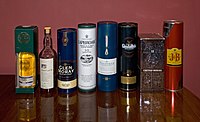Whisky Catalog by Alternative Whisky Academy
This is a whisky catalog with information about the different types of Whisky, Whiskey and Bourbon, sorted by contry.
If you want to buy whisky please check this page to find a whisky shop -> http://www.awa.dk/whisky/wshops/index.htm
Sorry but have an estimated +5000 pages to convert and only +1000 reached ... (Working hard to update all pages).
AWA - Alternative Whisky Academy is a private, none-commercial, no-profit, none-selling whisky society. (Private owner for private usage.)
We do NOT sell whisky or anything else.
|
WHISKY - THE HISTORY.: |
|
(MJ) The wild yeasts of the atmosphere spontaneously cause fragmentation of natural sugars. This produces alcohol - turning grapes into vine and grain into beer. The art of distillation was used by mariners (to render sea water drinkable), alchemists, makers of perfumes, and eventually in the production of medicines and alcoholic drinks. (The MJ part is to be continued....) Main article: Scotch whisky Scotch whiskies are generally distilled twice, though some are distilled a third time. In fact, in 2009 the Bruichladdich distillery released a quadruple-distilled whisky called X4 + 3. It was the first ever official whisky of its type.International laws require anything bearing the label "Scotch" to be distilled in Scotland and matured for a minimum of three years and one day in oak casks, among other, more specific criteria. An age statement on the bottle, in the form of a number, must reflect the age of the youngest Scotch whisky used to produce that product. A whisky with an age statement is known as guaranteed age whisky. Scotch whisky without an age statement may, by law, be as young as three years old. The basic types of Scotch are malt and grain, which are combined to create blends. Many, though not all, Scotch whiskies use peat smoke to treat their malt, giving Scotch its distinctive smoky flavour. Scotch whiskies are divided into five main regions: Highland, Lowland, Islay, Speyside and Campbeltown |










